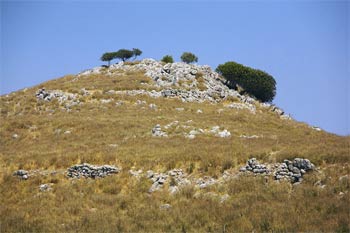Ephyra
A site mentioned by Homer, Ephyra, a Mycenaean colony, is located on a hill 500 m north of the Necromanteion (Oracle of the Dead) (the place today called Mesopotamos).

Description:
As early as the fourteenth century BC, Mycenaean traders founded a colony on this and other spots on the west coasts of Epirus (such as Toryni at Kiperi, east of Parga), with the aim to facilitate commercial contacts to the Epirotan inner land and mainly to exploit its abundant livestock. There is no doubt regarding its location by the Acheron River and the Acherusia Lake, since it is also referred to by the historian Thucydides some centuries later (Book 1, 46, 3-4) in the description of the anchoring of the Corinthian fleet and their allies in this area before the naval battle against Corcyra at Syvota (433 BC). The great historian narrates that: “[...] at some distance from the sea, in that part of Thesprotia called Eleatis, lies the city of Efyra, near which the Acherusian lake finds a way out to the sea; the river Acheron whence the name is derived, flows through Thesprotia and falls into the lake”. Besides this important written source, findings on the hill, on which the Necromanteion was built later during the Hellenistic period, confirm human presence already there already since the Late Bronze Age. Three box-shaped infant graves which were found in the courtyard of the Hellenistic temple, potsherds and a bronze sword which were found on the hilltop date back to exactly this period: fourteenth–thirteenth century BC. This evidence would clearly have been much more abundant if the hilltop had not been flattened for the construction of a vast Hellenistic sanctuary that destroyed all previous evidence.


